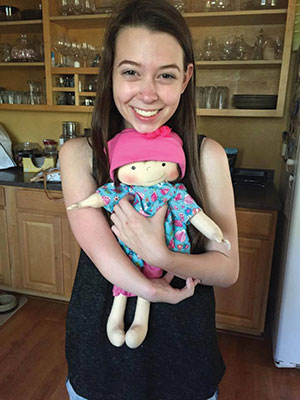
Susan Ferris had for 17 years tried to find a company that could make a doll with an arm and hand like her daughter’s — Rachel, 17, Napa, Calif.
What does a toddler with no arms do when her mom gives her a doll? She hugs it lovingly with her legs, of course. Especially this doll: a doll withno arms. One that looks just like little Emily.
Amy Jandrisevits, creator of A Doll Like Me, happened into the work of crafting dolls with limb differences, cuddly replicas of their recipients.
You could call it a Frederick Buechner moment. He is the theologian who famously wrote: “The place God calls you to is the place where your deep gladness and the world’s deep hunger meet.”
“Doll making combines my love of dolls and passion for social work,” said Jandrisevits, a former pediatric oncology social worker and a member of Cross Lutheran Church in Milwaukee. In October 2014, a woman asked Jandrisevits to make a doll for her daughter, whose leg had recently been amputated.
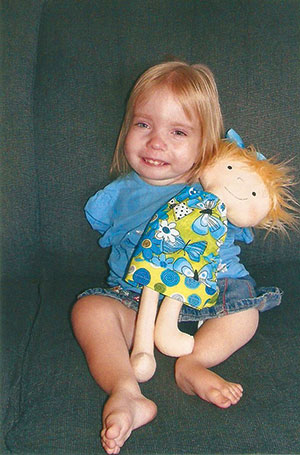
Kimmy Allison, San Diego.
“I’d never considered the idea, but it was a no-brainer,” she said.
The woman posted a picture of the doll on Facebook, and that photo sparked a business.
“I hate calling it a business. I like to call it a labor of love,” Jandrisevits said. “I mean, where can you get a doll with missing fingers or missing limbs? I have only sold these dolls via Facebook. I’ve been fortunate in that it’s been entirely word of mouth.”
Stories and photos of people who have received Jandrisevits’ dolls are posted on her Facebook page, A Doll Like Me.
After only a month, Jandrisevits had more than 100 orders. And last December, a video of a surprised and tearful young girl opening a package with her limb-different doll went viral. By Christmas, Jandrisevits had 200 orders.

Ellie is the daughter of Miranda Todd, who said that when her doll arrived from Santa last year: “I guess Santa knows my hands!” They live in Texas.
That’s when she called on her mother, Christine Davis, a member of Trinity Lutheran Church, Hawthorne, Calif., who taught Jandrisevits to sew and now helps her make dolls and clothes. A friend helps her stuff them.
“My mom used to make dolls for me. It’s so important for children to see themselves represented in their toys — whether it’s skin color, eye color, ethnicity or limb difference. I wanted to make a cuddly doll so that children could take them to bed,” Jandrisevits said.
She is now attempting to keep up with orders from all over the world, including Chile, Australia, England, Ireland and Canada. Even without the doll business, she’s busy. At 42, she and her husband, Matt, parent their sons 10 and 6 and a girl born in August.
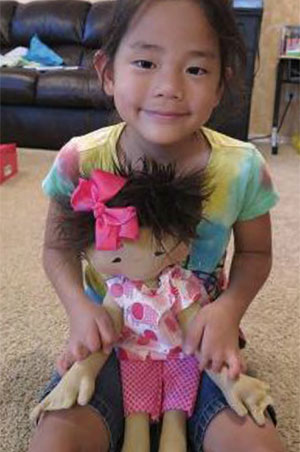
Louanne Mason’s daughter Amelie was adopted from China just before she turned 2. When they brought her home to Texas she didn’t know how to pretend play and had no interest in dolls or stuffed animals. After receiving her Doll Like Me for her 6th birthday, her mother said, “she sleeps with her, takes her everywhere and plays with her like little girls do. It’s been such a blessing to see her bloom in this way and see her delight in the doll that she thanks us for all the time.”
Jandrisevits is a one-woman show. Friends encouraged her to hire employees, but Jandrisevits said she feels that would take away the personal touch. “I look at the doll making much like making a prayer shawl. I like to sit and think about each child as I make their doll and hope that the doll will provide some type of comfort.”
Jandrisevits believes it’s important the children know that their limb differences don’t define them. “It is my heartfelt belief that dolls should look like their owners and dolls should be available in all colors, genders and body types,” she said. “I think that’s so important for a child … particularly a child who has never seen him/herself reflected in a doll before.”
Her dolls are affordable, well under $100, and she makes them for girls and boys. About every third doll order is for a boy.
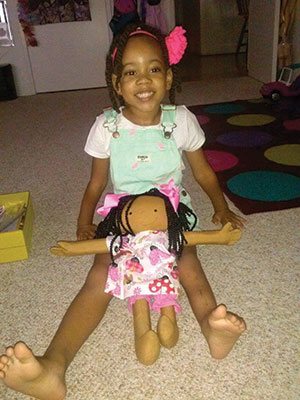
Hayden Betts, Waikoloa Village, Hawaii.
“This whole experience has been so fun and so humbling, as overwhelming as it can be,” she said. “I love seeing the kids get their dolls, and it makes this labor of love worth it.”
The doll-making business has taken on a life of its own, Jandrisevits said, and one thing she didn’t anticipate was hearing from strangers who want to donate dolls to kids they’ve never met. “They always refer to it as a ‘pay it forward’ gesture, and it’s one of the kindest, most selfless things I’ve seen,” she said. “That is a part of this doll making that I never expected, but it’s absolutely where I find the most joy.”
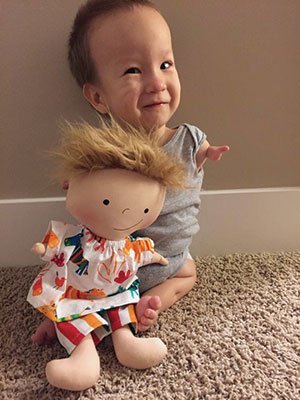
Zaure Ibrayeva, Washington, D.C., said her son Beknur “now knows he’s not alone. That doll teaches him to accept himself the way he is.”
Jandrisevits hopes her customers understand that she might have to slow down her doll making now that baby Kalea has arrived.
“I’m just praying she is a good napper,” Jandrisevits said prior to Kalea’s birth. From the latest reports, she is.




